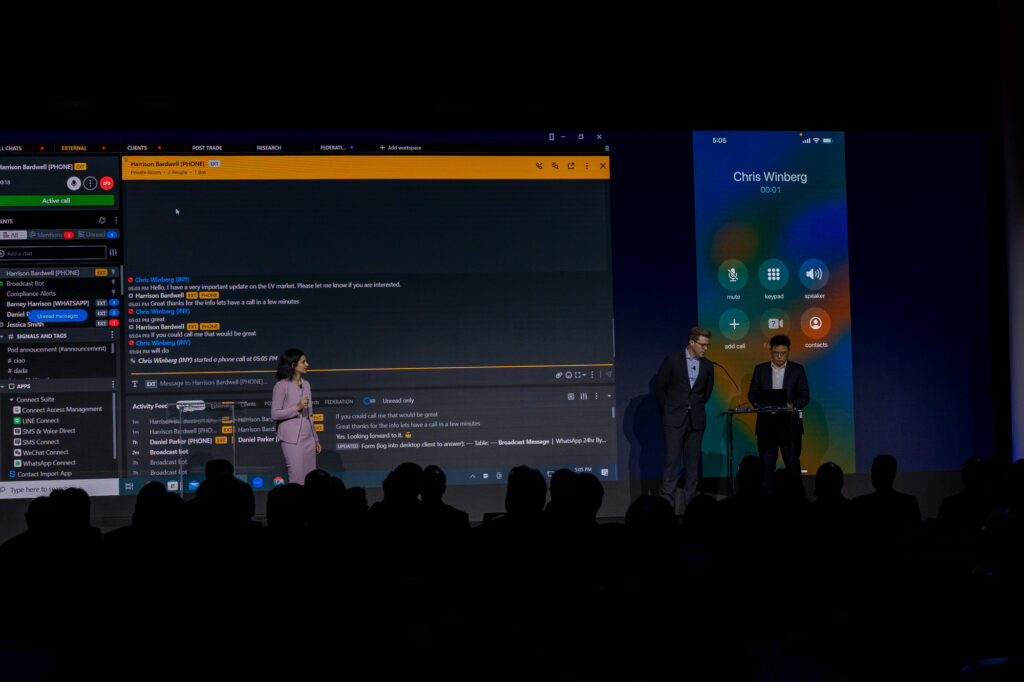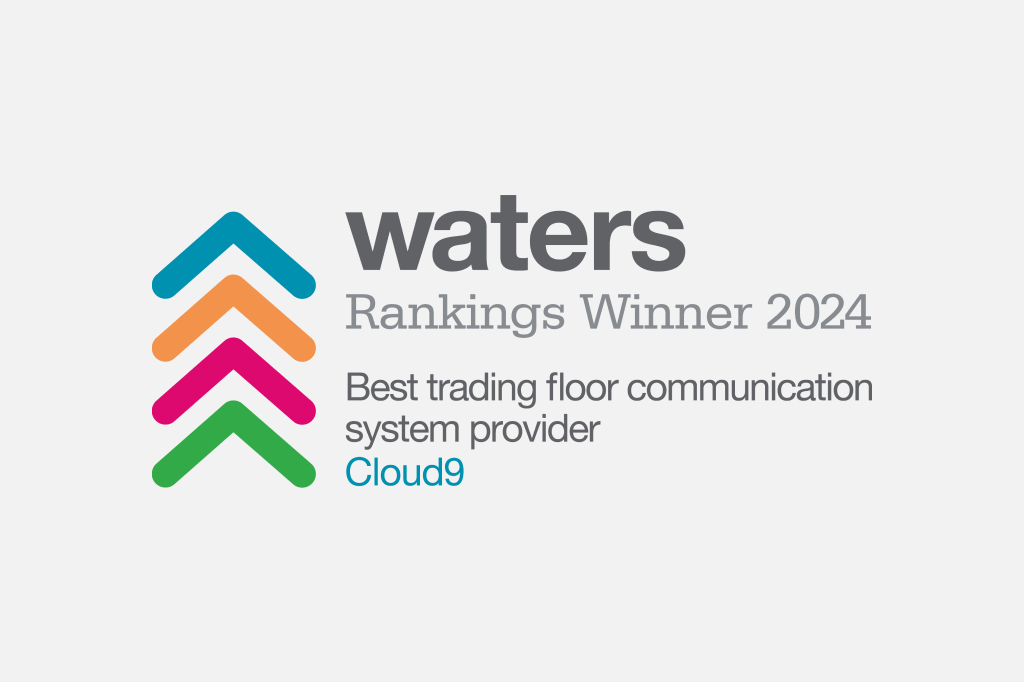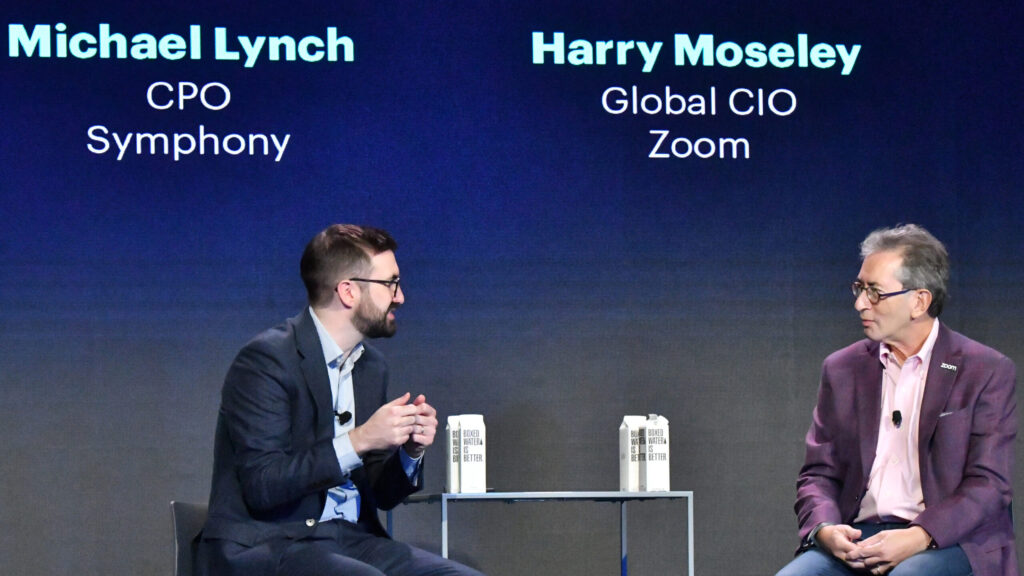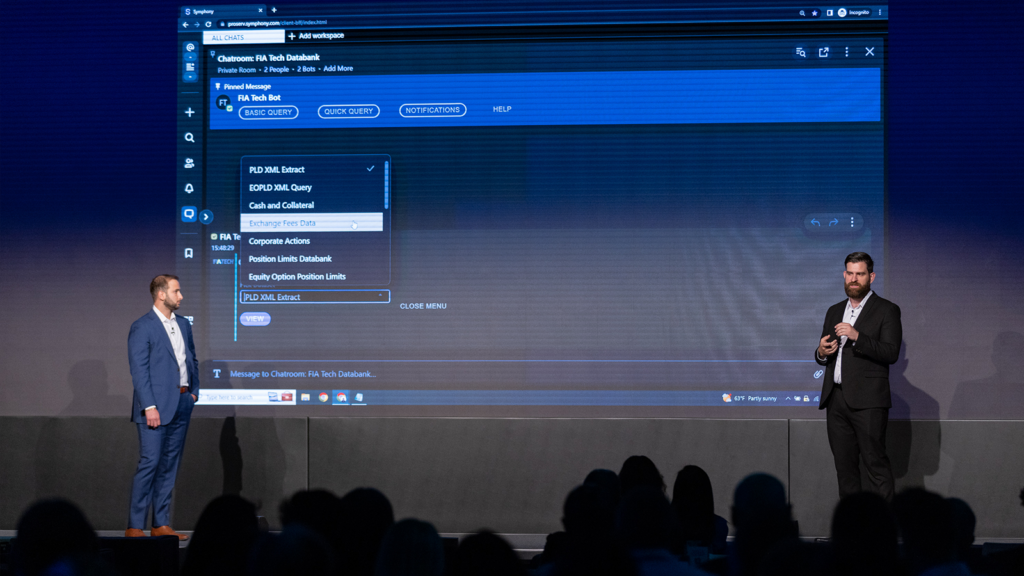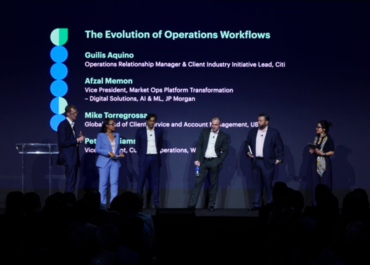Symphony Innovate 2019 brought together over 600 executives and technology experts to discover how to streamline secure collaboration, connect information systems, and automate workflow across global markets. Thirty-five speakers from seventeen different customer and partner organizations demonstrated their solutions live on three different stages, and discussed the opportunities and challenges that our community and the financial industry at large will face over the next five years and beyond.
Symphony founder and CEO David Gurlé kicked off the day’s activities with an overview of the main pressures facing the global markets: complexity, inefficiency, cost pressures, and regulation. David emphasized collaboration and trust as critical tools for rewiring the financial community to address these pressures and achieve progress. Read on to see the transcript.
David Gurlé, CEO, Symphony: Who said I don’t get surprised? First of all, Sashi made a fantastic introduction and I want to start by thanking you and partners and Symphonians and the whole crew that is setting this thing up so that we can deliver you an amazing day with innovations that I believe is definitely going to open up your eyes and entice your imagination for what tomorrow looks like. We’re going to have throughout my day today, half a day, a range of people coming in and out and we’re going to do a set of live demos and those demos are put together as you know in the last few days and they are going to be cliffhanger moments. We are not only going to give you joy of seeing what everybody is innovating on but we are also going to make sure that you have a little bit of fun seeing things coming together for the first time on stage at Innovate. I’m sure you’ll get a kick out of that.
Before I start, there is one thing that really surprised me last week that I want to bring to your attention. I was in Tokyo, meeting with one of the mega banks as we call it in Japan. It is what we call a quarterly business review so it’s a formal meeting, the CEO and his crew and my team, we go, the meeting is in English, but there is a little bit of Japanese going on. We sit down with our deck well-prepared through which we review the activities between us and our customer. As we sit down, one of the delegates of this mega bank stands up and opens his presentation and then starts handing over to us their QBR deck about Symphony.
It’s the first time ever I have seen a customer doing this in a meeting with us where they are reviewing with Symphony what is it that they’ve been working on in Symphony since the inception of our relationship. As I flip through the deck and as they walk us through this deck, what I am looking at is giving me goosebumps – I do not see just innovation happening, I see hope. I do not see work, I see bright horizons – and they are so proud of the investments that they are carrying on with Symphony and they are showing why Symphony is helping their business transcend its own limits.
That gave me pause and I asked them, “Look, can I actually frame this presentation? Because that is definitely the first one.” That is the theme that we’re going to walk us through today. You’re going to see not only what we will share with you but also mostly what our customers and our partners and ecosystem are going to share with you. We’re going to walk through this journey but before we do so, let’s look at the underlying technology trend that we’ve been riding since the inception of Symphony just five years ago.
We’re going to look at key trends in the context of today but cloud, bring your own device, blockchain, AI, IoT, social networks, big data, were all the big hashtags at work that we have hoped or we invested in or we doubted that they will actually dictate the way our world is going to evolve around technology.
Five years from then, today, in 2019, not everything turned out to be what we hoped that people turn out to be. Blockchain is still there but it’s not really gained a particular community or attraction and I think there is still some work to do but there are a few that are really sticking around and they are creating what I call the tailwind or the tsunami upon which we are building our own innovation as if we were riding on the shoulders of giants. Cloud, bring your own device. There will be no AI without big data and obviously, social networks. That’s who we are.
While those technology innovations are happening and massive investments are going through all the way, from China to here and everywhere else around the world, there are some challenges and I’m going to also talk about that context because it’s important to think about and synthesize as I have the opportunity in my day-to-day life to meet with the CEOs and COOs of our community. I have the privilege of them sharing their own issues, their own priorities so I took the liberty to synthesize this all and look into what those pressures are that the global markets are facing.
The first one that I like to think about is an image, the image of the global market as a big, big boat. The reason I picked this image is because I see in the large sell side and large asset managers and even to some extent hedge funds that there is a lot to carry. There’s a lot to carry in terms of what the processes, what the information technology and what the people are doing every day to conduct their businesses. But what I observed is a set of headwinds.
The first one is complexity. Complexity is very interesting. They are a paradox in this world because over the last 20, 30 years, every actor in this industry has invested in information technology. Information technology has helped a range of innovation and processes come true and create all these products that financial markets are using every day. But it’s very complex due to the fact that the nature of financial and global markets is very fragmented. That fragmentation created layers of layers of the layers of legacy software infrastructure. Software that doesn’t communicate with another, not only across two firms but certainly within existing organizations.
One asset class operations doesn’t talk to other asset class operations so it’s very hard to find common denominators that you can pick up to create what technology companies do, the largest common denominator that serves the market. That is one hell of a challenge that I see and sometimes it has really negative returns.
Second observation is what I call operational inefficiencies. The front to back, back to front, front to back from one counterpart to another is certainly something that has not been optimized. I was talking to one of our CIO’s customers the other day in Singapore and he comes from the industry of manufacturing and he has spent some years there. He told me, “David, this is one of the most inefficient industries I’ve ever seen.” I said, “Why so?” “Well, if we were to build an iPhone using the processes and technologies that exist today in financial markets, it will cost us half a million dollars for each device.” I’m not sure whether the price is right but you can certainly agree that the production rate is challenged by a number of inefficiencies and those inefficiencies are there to drag this boat moving forward faster.
Next one is cost pressures, lower margins. The technology doesn’t only create complexity at the core layer of your businesses but it also facilitates, paradoxically, some of those things that are squeezing your margins. A number of financial instruments are moving and becoming commodities and if you have not been ahead of that investment in technology, it is super hard to make the right amount of profit in those asset classes. We have seen the backdrop of that over the course of the last few months in terms of news.
On the other hand, you have over-the-counter markets or private equity markets who are plagued with processes that are really, really stamped down by cost pressures. You are really trying to figure out a solution in order to accelerate how you can innovate in this space. I have a favorite quote from Churchill. He says, “Never waste a crisis,” and I’ll come back to that.
Before we go there, the last one, top of mind of every customer I have had the opportunity to talk to, is regulation. I put this in the boldest one and I put the boat really sinking down. It’s certainly not drowning but it is creating so much drag for this boat to advance faster than it should. Unfortunately, regulation isn’t decelerating, isn’t even staying still. It is accelerating and that rate of regulation isn’t going to stop by any means. That means that the systems you have to put in place, that means that the inefficiencies you have at the heart of your IT infrastructure through which you have to apply all these regulatory constraints is actually creating so much more cost and taking basically that money away from innovating and just doing barely your day-to-day job of serving your existing customers.
These are all the pressures. I’m sure there are a few more but what I would like to tell you is that there is a bright side to all of that and yes, never waste the crisis and there are opportunities so that we can take advantage of everything that happens on these pressure points. I want to represent that with this nice parachute. Originally, we wanted to put the Symphony logo there but I felt that putting this box, which kind of encompasses all of the ecosystem that we serve, is more representative of the solutions to come.
If you do the right thing, here’s what’s going to happen. First of all, we can anticipate regulation and here’s what it means. It is not like regulation is unknown. In other words, there are your compliance organizations, your legal organizations, operations team, are constantly working with the regulators and there are opportunities to influence those regulators, opportunity to use the technology in the right place to streamline those processes. But the greatest want is transparency. We can provide you, you can provide that information, obviously, to the market and to the regulators.
Second element is cost pressures. This is where really the world of taking advantage of a crisis works to your favor. Yes, you have to cut cost but it gives you an opportunity to go deep under the stock and say, “You know what, I am going to make a big bet and remove this because if I don’t, five years from now, this business is not relevant anymore.” That is an advantage that you have thanks to the technology stack that is coming to market these days, such as Symphony and all the cloud providers.
That is going to help you go and create automation capabilities through which you can streamline your businesses, remove those inefficiencies, and we have seen this and we’re going to see this today just so many times on stage. It is certainly going to open your eyes and inspire you to go and repeat and iterate and innovate.
Last but not least, you can simplify. The simplification is something that I am absolutely, absolutely passionate about. It is a relentless pursuit of perfection. That perfection is all about finding ways in which we can wake up everyday to do something better than we did yesterday. If we do all these things right, we’re going to rise this ship but we can’t do that just by wishing it because today that’s what happens. Today, the fragmentation, the information systems, the instruments that you create, you market, you sell, you trade, you settle, are all going through just so many layers and layers of communication and systems where humans are acting barely as semaphores, copy-and-paste people, putting data from one system to other systems and therefore, making these operations inefficient, expensive and full of friction.
These companies that I have the honor of hosting today are going to come on stage later today and tell us how they are embracing the technology trends we just talked about, the pressure points that we are going to leave through those key initiatives so that we can streamline this bus and create this trusted infrastructure, this workflow platform, this collaboration-driven innovation, through which doing things will be faster, more agile, cheaper and will help you to focus on the essential, which is serving your customers better.
You’re going to see this theme today repeated over and over and over again, so much so that I’ll tell you what happened as we were preparing for this conference. Obviously, we have to put an agenda together and traditionally, although we are only five years old, we have the keynote in the beginning and then there’s a closing note in the evening. I have the honor of hosting one of our industry to do so but there was so much demand from our customers that we had to actually yank my session in the evening so that we can bring on stage all of these customer innovations so they can demonstrate what innovation truly means for them. I’m very, very proud of that.
But this happens for a reason and for me, if I were to really unpeel the onion layer after layer after layer after layer, I will just come to this one single word, it’s trust. The trust that we are not Symphonians in your way of doing your business. Trust that you can rely on our security model. Trust that through our infrastructure you can meet your regulatory compliance requirements. Trust that you can actually serve your customers faster and more agile.
What really happened over the course of the last 18 months is not only the number of bots and applications that are coming up. It is that we have truly become a B2B marketplace. Marketplace in which people are building their products on Symphony. They are marketing their products on Symphony. They are getting paid through their other management systems and settling those on Symphony. Arriving to that milestone for me is a significant, significant moment that I see it as something that we used to call in the industry and we still call this a tipping point. I’ll come back to that.
If we have trust, well, it propels progress. The progress will be interesting in the context of Symphony. As Sashi said, this is our fifth anniversary, so I want to say happy birthday. Please don’t sing happy birthday. Happy birthday to all Symphonians, to all of our investors, all of our customers, all of our partners on the ecosystem. I’d like to take us on a short journey of our accomplishments today which by all means are happening thanks to you and thanks to your trust.
So 2014, the company creation, building the team, which kind of arrived in 2015 where we built the software that is still in the market today. We launched the Symphony application in 2016 and as we go live, we were looking at growing our business, growing our community. By the end of 2016-2017, in Innovate 2017, we shared our first progress report, our scorecard. 250,000 users over 200 companies and about 26 million messages sent. A year later, 2018, 375,000 users, 350 companies, 40 million messages and about 500 plus bots, applications working in production.
I’m very pleased to share with you our progress to date, now in 2019. 450,000 users, there’s been more actually, over 400 companies, 1.2 billion messages. Thank you. I honestly thought that my team had made a mistake. It was 120 million and they added one more zero. No, no. They said, “No, no. David, this is right.” And 1,300 bots in production.
There’s some data that I didn’t put here but I’ll share with you is about 20% of that volume of 1.2 billion messages is generated by these very bots that you, our partners, have built. We’re going to see them in action. I think about a company in enterprise software market in a 10-year horizon. The first five years has been our journey to date and we have built what I call lots of potential energy which hopefully you can see progressively and faster and faster transform in this kinetic energy.
We are about to go into the second half of our journey. Second half of our journey is going to give us a much further growth which I can see every day. Today is going to be a testament to that and when I will wrap up this evening, and hopefully, honestly, many of you then will go and count that and we’ll see if we have made the progress that I’m expecting and we are expecting that and we are hoping. As we build that business, this infrastructure, this community, this ecosystem, we did it on the back of what we call the social operating system.
The social operating system is essential because Symphony in its technology definition universe is actually a social network. If social networks exist is because it really serves its participants with greater benefits than just on point-to-point conversations. This is a moment in which the collective intelligence, the collective knowledge rises. In the past what happened on the left side of the organization was not known by the right side of the organization and through social networks like Symphony, now that information is available at the fingertips of every participant. Suddenly, the person in Hong Kong is as smart as the person in New York. When the day starts, they know what to focus their business energy on. That is the building block to the real mission of Symphony, rewiring the global market’s infrastructure.
If you were to really think about what we are doing, what our mission is, what we are working on, is building this infrastructure, giving you that connectivity that you can trust, giving you the platform and the collaboration of your application upon which you can bring the different data sets and enable this seamless transition from human to human, human to machine, machine to machine, is what I call this getting rid of this digital distance that separates information from knowledge, knowledge from intelligence, and that is what the future is for us. We’ll come back to that.
This is our actual Splunk data. I hope you heard about the word Splunk. It is a very expensive piece of software, don’t buy it, but we have it. I asked the team to pull this actual data. This is our network, look at that. Look at where all of our customers are messaging from. Last week, I looked at the same data and I’m really annoyed that the data is not available today because there was a dot here in Hawaii and I was wondering who this customer in Hawaii is that needs David Gurlé’s personal support. Unfortunately, that person actually came back from vacation so I can’t go there and help them with all the cool things that Symphony is doing.
This, we track this on a regular basis but if you look at the distribution of these dots you see that it is global and it is where your global presence is, where your global presence is required, and I am very proud that for an organization who’s just five years old we’ve already been able to achieve this global presence. It comes at a cost, I must admit. I traveled 266 days out of the last year and I don’t think I’m going to do anything less this year but it is very fascinating. It is giving me the energy which I hope you can feel and the goosebumps when I see customers like this institution in Japan who shared what they are doing with Symphony.
The next five years is what we are going to talk about for the rest of the day. It is going to be a different theme. Organizations like ours, like yours, have to think about these horizons and those horizons are the cyclical horizons. What has worked for the last five years is going to be a very different set of assets for the next five years. I do not think that what we used to do is going to work for the next five years. We have to reinvent ourselves. We have to think differently so we can serve you better and we’ve been thinking about that for some time.
So I got a surprise for you today. We’re going to make some announcements which hopefully will show you that even an organization, which is a startup, a Silicon Valley startup which is going at 300 miles an hour and heads down all the time, has to go and take a step back and try to figure out if we are heading with the right technology in the right direction.
Stay tuned for more of the opening keynote transcript to learn more about Symphony Market Solutions, Symphony 2.0 and more.


